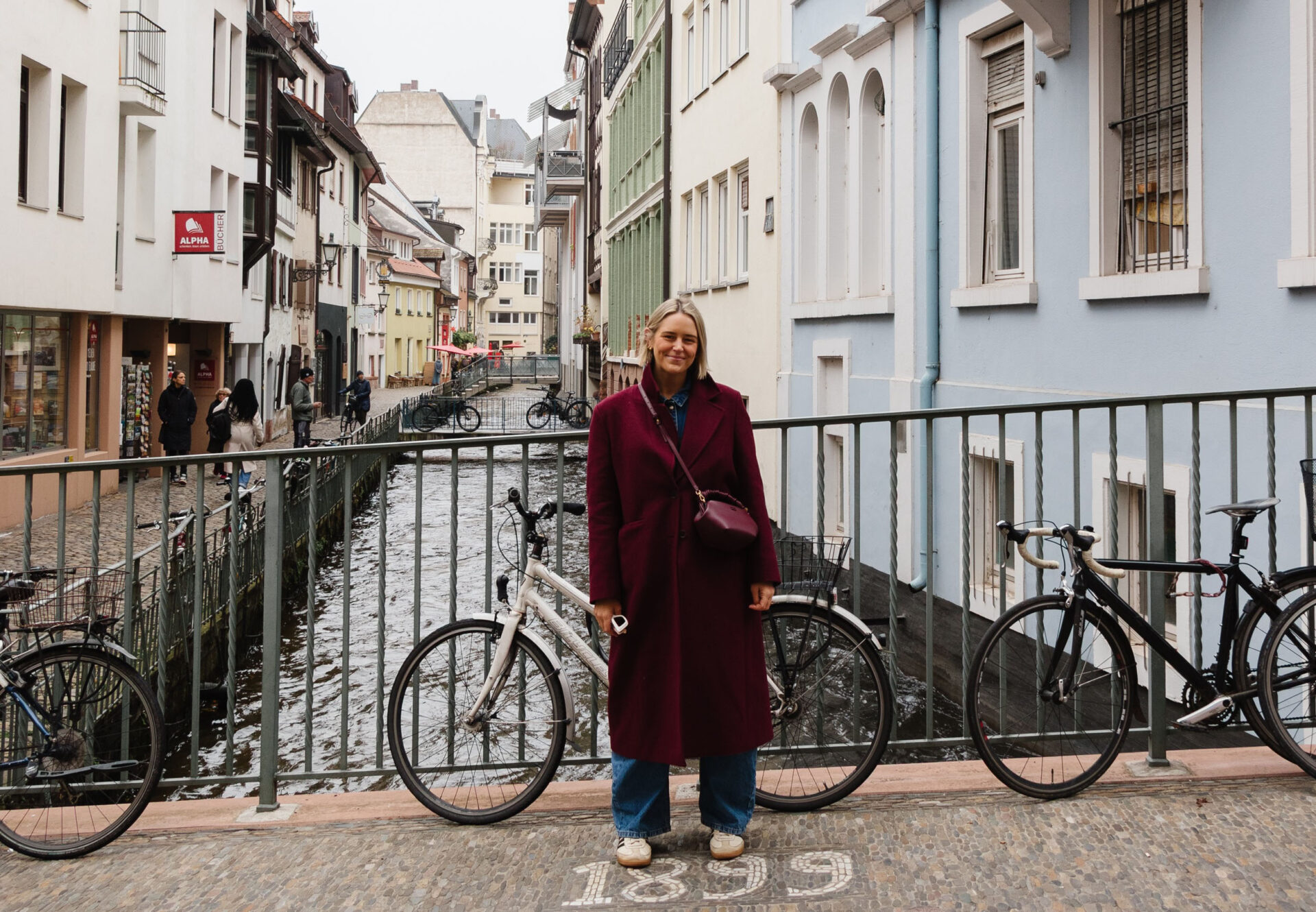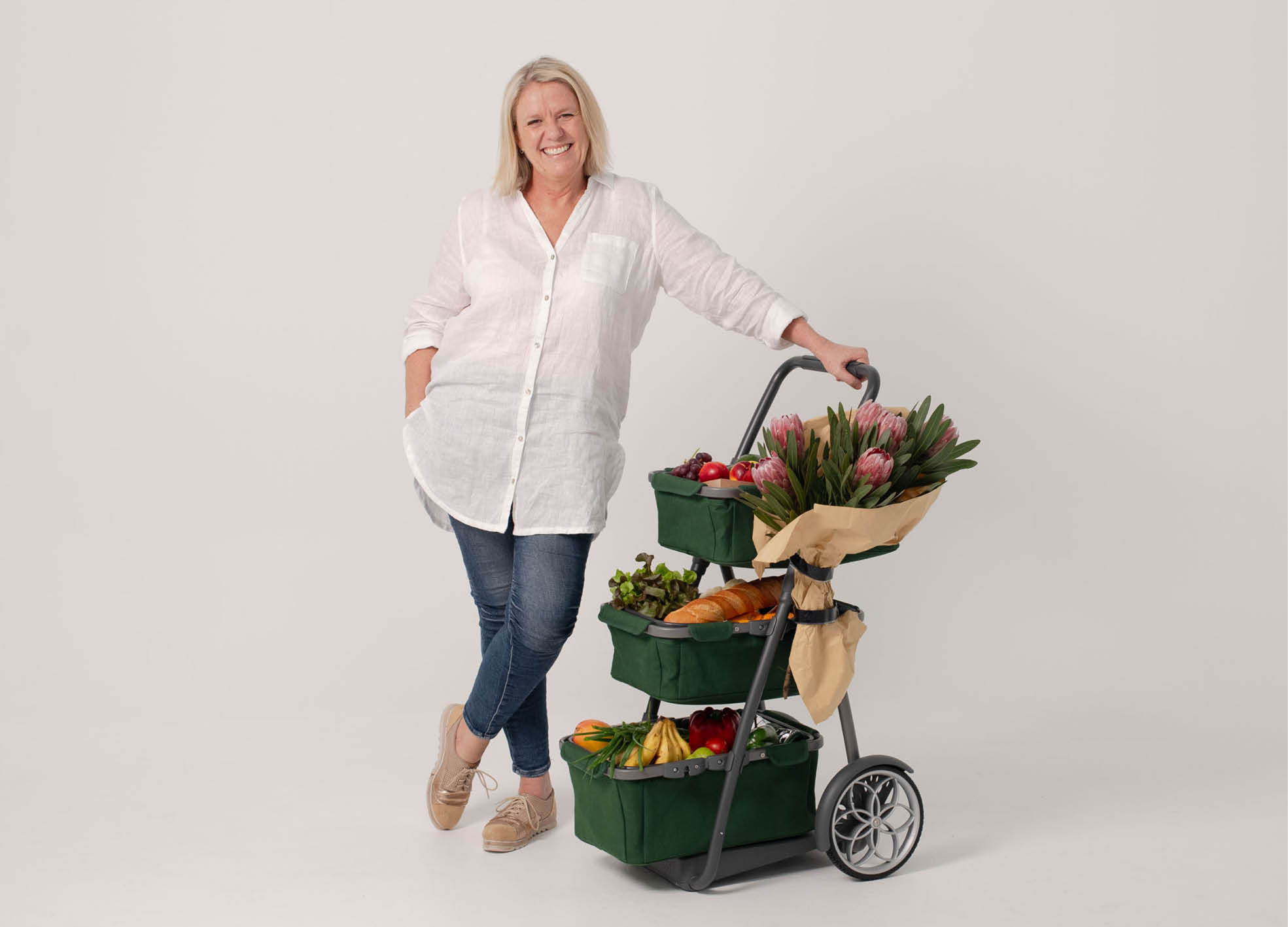Yotam Ottolenghi Takes On an Australian Barbecue Classic (and We Have the Recipe!)
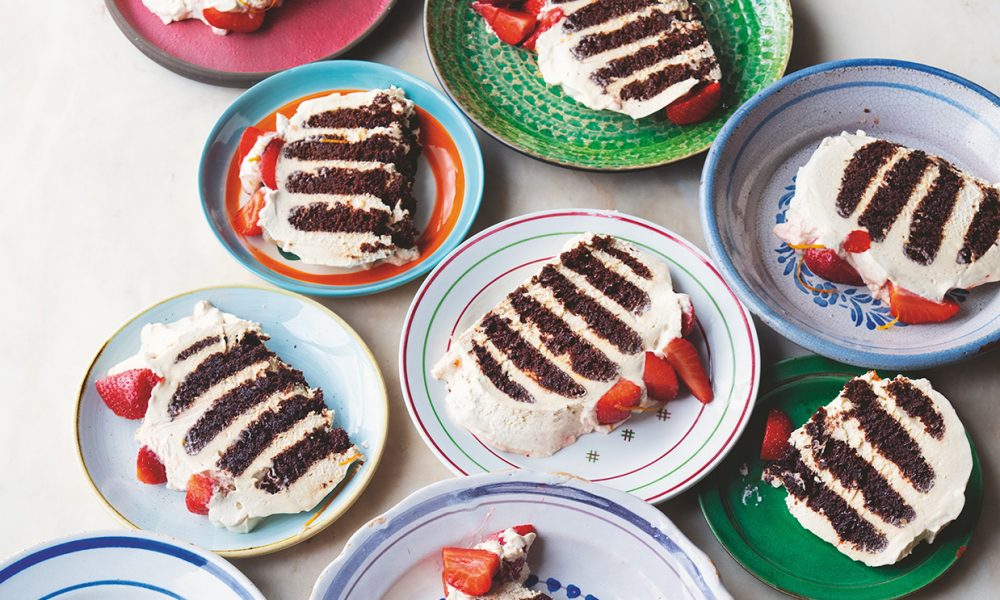
- Words by Peppermint
Big news! The master of plant-based recipes and all things eggplant – Yotam Ottolenghi – has launched a cookbook dedicated to comfort food. Oozing with nostalgia, the dishes in COMFORT are the kind that make you feel warm and fuzzy on the inside. We’re talking big bowls of nourishing food best eaten on the couch with the telly blasting. Social graces be damned!
Described as “nostalgic but novel”, the recipes in this book are elevated takes on dishes you might have grown up with, like pea and ham soup, roast chicken and jacket potatoes. They appear alongside comfort dishes from all over the world, such as boureka, caponata and steamed eggs. Yotam’s co-authors – “the four hungries” – have each contributed comfort food from their own well-travelled lives.
Here, Yotam and his co-collaborators share their inspiration and the food they eat when they’re all alone. Plus, he shares two recipes (including co-author Helen Goh’s take on Australia’s Chocolate Ripple cake)…
images JONATHAN LOVEKIN
 Who are the four hungries and what are your backgrounds?
Who are the four hungries and what are your backgrounds?
Helen, Verena [Lochmuller], Tara [Wigley] and myself. It’s a fair bit of global ground. Helen’s stretches from China (from her grandparents) to Malaysia to Melbourne (where she was raised) to West London. Mine takes in Italy and Germany (from my parents), and Jerusalem to Amsterdam to London. Verena’s takes in Germany and Scotland to New York (where she trained) to London. Tara was born in Khartoum, grew up in London, spent a year eating tapas in Barcelona and three years in Sarajevo, focusing largely on aubergines.
Tell us about the link you found between comfort food and movement, and between food and immigration?
For us, it’s a key link. For anyone who lives somewhere other than the place they were born and grew up, food is the most effective way of connecting with the smells and tastes and memories of home. You might not be able to magic up your mother or your childhood bedroom, but making the soup or stew or stock that filled your house with the smell of home as a kid can get you pretty close.

This book is a celebration of movement, immigration, family and home. You talk a bit about how for you it’s cultural appreciation, not appropriation. Could you talk a little more about that?
So long as all roots are acknowledged and credit is given at every turn, then we’re fully signed up to the ‘appreciation’ (rather than ‘appropriation’) school of thought. Appropriation is a recipe without the story. Appreciation is the recipe plus the story. Recipes are not static things: what keeps them alive is being shared, remade, passed on.
What do you like to eat at home on your own?
Quick toasties that I fry in a pan, using whatever cheese is around, plus a pickle or ferment. Cheddar and feta, for example, with sliced gherkin, or comte with kimchi. A good smear of butter, mayo or mustard (or all of them) as well.
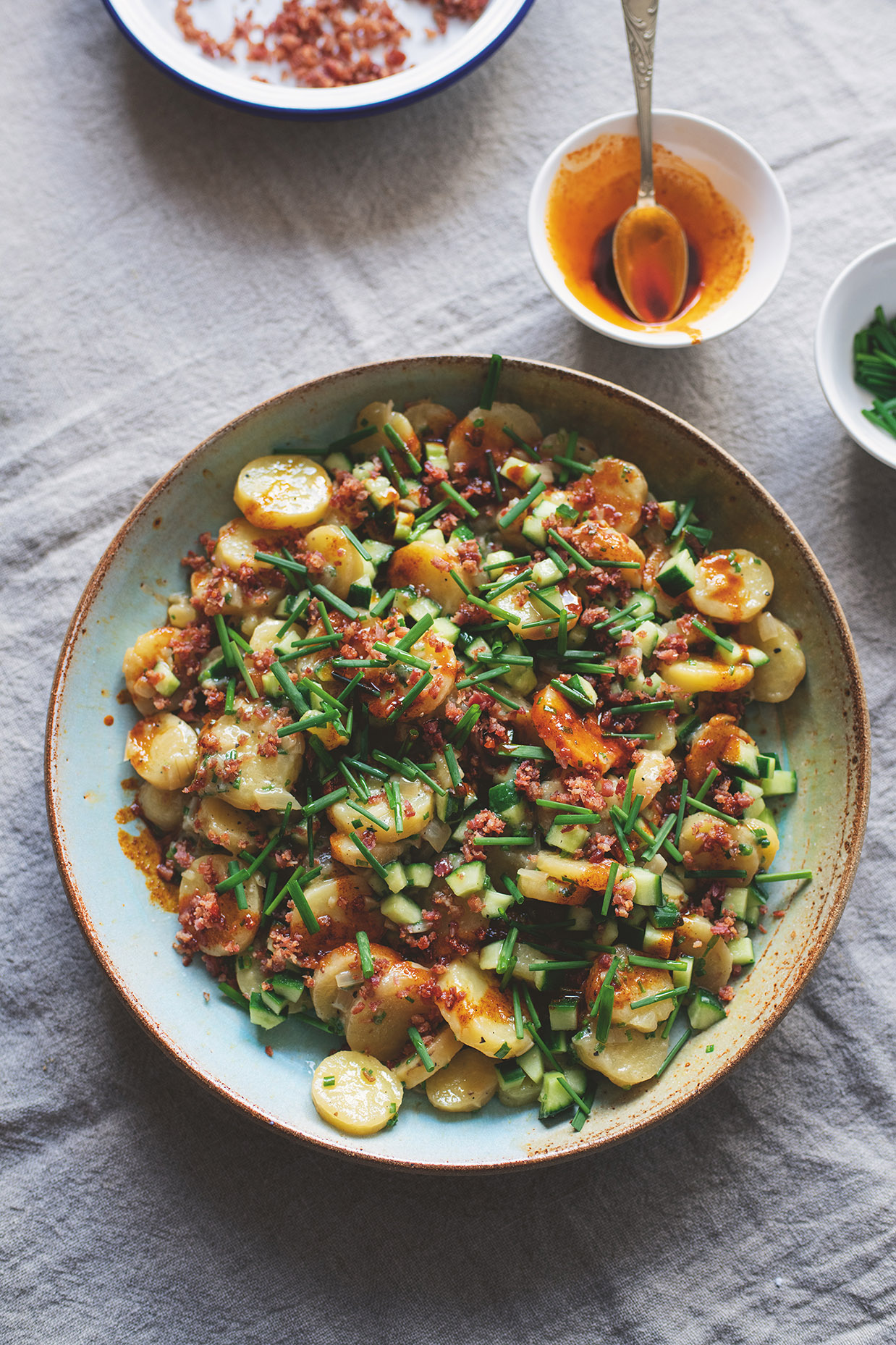
Verena’s potato salad
Growing up in Germany, Verena remembers two camps when it came to potato salad: camp mayo and camp oil/broth. This is an oil/broth-based version, more prevalent in the southern parts of Germany, specifically Swabia and Bavaria. It’s less heavy and claggy than the mayo variety and gets its creaminess from the starch released by the potatoes as they sit for a couple of hours in the warm broth. We’ve strayed from tradition and added some pancetta (because, why not…) and a welcome freshness from some chopped cucumber.
Serves 4
INGREDIENTS
500a Pink Fir or Charlotte (or other waxy) potatoes
75ml olive oil
1 small onion, finely chopped (125g)
1 garlic clove, crushed
175ml chicken stock
2 tsp Dijon mustard
2 tbsp apple cider vinegar
½ tsp black peppercorns, coarsely crushed in a pestle and mortar
15g chives: 10g finely chopped and 5g cut into 1½cm lengths
75g pack of diced smoked pancetta
1 tsp paprika
¾ cucumber, sliced lengthways, deseeded and cut into ½cm dice (100g)
salt
METHOD
Put the potatoes into a medium saucepan. for which you have a lid. Add just enough water to cover, salt generously and place on a medium-high heat. Bring to the boil, then reduce the heat to medium low and cook, covered, for 20-25 minutes, until just tender. Drain and, once cool enough to handle, remove the skins from the potatoes and slice into ½cm-thick rounds. Set aside in a medium bowl.
Put 2 tablespoons of the oil into a medium sauté pan and place on a medium heat. Add the onion and cook for 12–15 minutes, stirring regularly, until caramelised. Add the garlic and stock, bring to a simmer, then remove from the heat. Add the mustard, vinegar, 1¼ teaspoons salt, the pepper and another 2 tablespoons of oil. Whisk to combine, then pour the mixture over the potatoes. Mix gently but thoroughly; it will look wet (and some of the potatoes will break up), but this is normal. Set aside for about 2 hours, for the potatoes to soak up about half the broth, and then stir in the finely chopped chives.
Meanwhile wipe clean the sauté pan and place on a medium-high heat. Add the pancetta, reduce the heat to medium-low and cook for 10–12 minutes, stirring occasionally, until the pancetta is crispy. Using a slotted spoon, transfer to a plate lined with kitchen paper – leave about 1 tablespoon of the fat in the pan – and set aside. Once cool, finely chop the pancetta into crumbs.
Add the remaining tablespoon of oil to the fat in the pan, along with the paprika. Stir for 30 seconds or so, until fragrant, then remove from the heat.
When ready to serve, fold the cucumber into the potato salad and transfer to a serving plate. Scatter over the pancetta crumbs, along with the cut chives. Spoon over the paprika oil and serve.
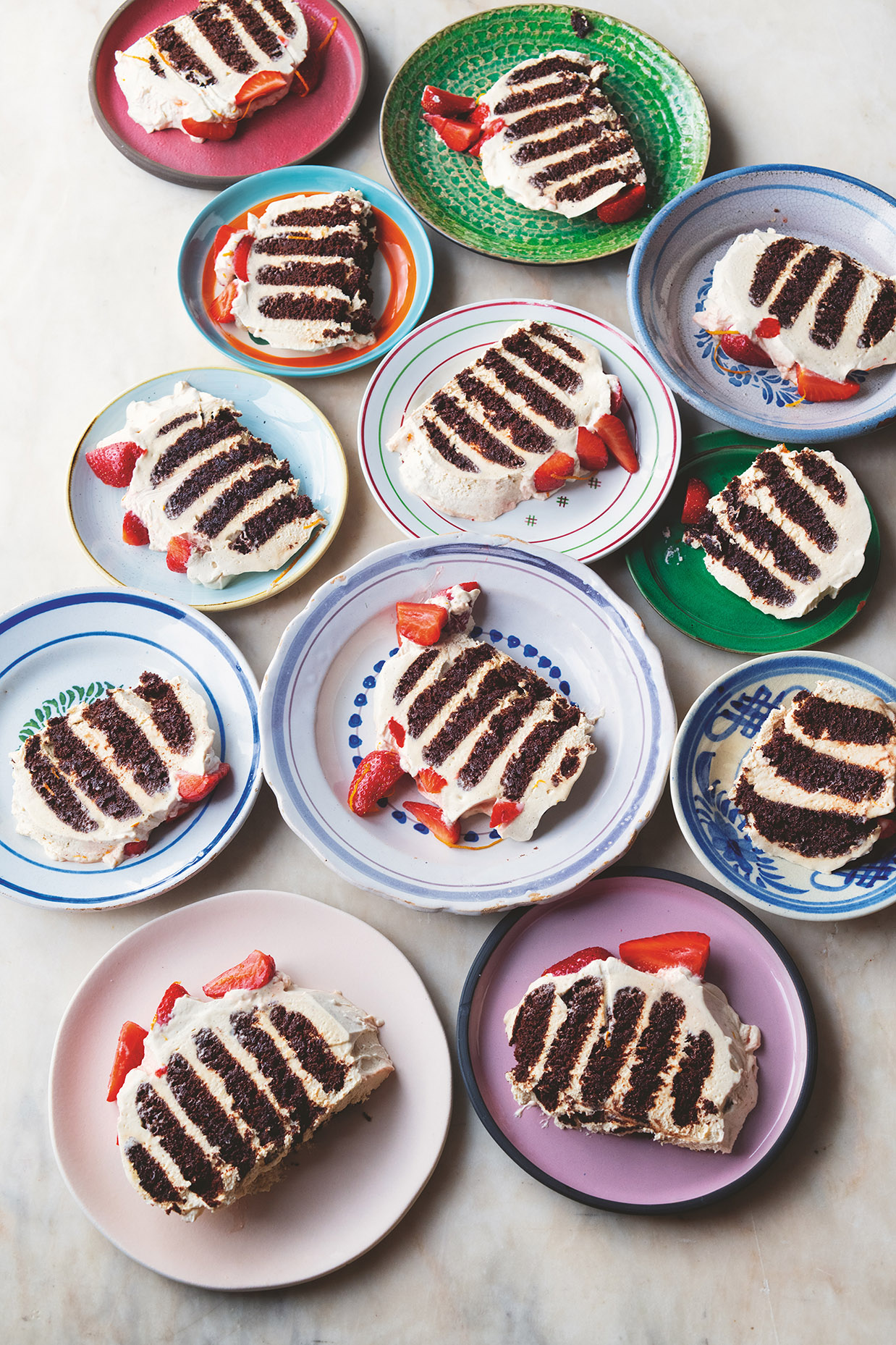
Chocolate ripple fridge cake
As anyone who’s ever been to a proper Australian barbecue will know, chocolate ripple cake is a ubiquitous, no-bake dessert. In Australia, it’s made with shop-bought chocolate biscuits which are then sandwiched together with cream. The recipe is so simple that it’s written on the back of the biscuit packet! On a recent family trip back to Melbourne, Helen’s kids were so taken by the cake that they begged her to make it back in London. Not being able to get hold of the right biscuits – Arnott’s Choc Ripple (though they are now available online) – Helen made them from scratch. They’re so quick and simple to bake that Helen now not only bakes them to make the cake but, also, makes extra biscuits to have around. No birthday party (or barbecue!) is complete without them.
Getting ahead: The biscuits can be made and baked up to 7 days in advance, kept in an airtight container. The cake needs to be made up to 6 hours before serving, to allow it to soften and meld together, but can be made up to 2 days in advance, left to sit and wait in the fridge.
Playing around: The strawberries work really well here but, and an alternative, just crumble over another cookie or a chocolate Flake.
Serves 8-10
INGREDIENTS
3 tbsp milk (or 105ml if you’re not using the Grand Marnier)
60ml Grand Marnier (if using)
1 espresso shot, regular or decaf (30ml)
650ml double cream
325g crème fraîche
50g icing sugar
1½ tsp vanilla extract
1½ tsp ground cinnamon
Biscuits
225g plain flour
50g cocoa powder
¾ tsp baking powder
½ tsp bicarbonate of soda
¼ tsp salt
100g unsalted butter, at room temperature
200g caster sugar
50ml vegetable oil
50g golden syrup
1 egg
Macerated strawberries
600g strawberries, hulled and quartered
1½ tbsp caster sugar
1 tsp finely shaved orange zest
2 tbsp Grand Marnier (or orange juice)
2 strips of orange zest, julienned
METHOD
First make the biscuits. Sift the flour, cocoa powder, baking powder, bicarbonate of soda and salt into a medium bowl.
Place the butter, sugar, oil and golden syrup in the bowl of a stand mixer with the paddle attachment in place. Beat on a medium speed for 2 minutes, until light and creamy. Scrape the sides of the bowl, then add the egg and beat again until combined. Reduce the speed to low, add the dry ingredients and mix until the dough comes together. Wrap and chill in the fridge for at least 2 hours.
When ready to bake, preheat the oven to 170℃ fan.
Pinch off 30g pieces of dough and roll them into balls, then place them, spaced about 5cm apart, on two large parchment-lined baking trays. Flatten them with your hand – they should be about 5cm wide – then bake for 15 minutes, until firm and the tops are cracked or ‘rippled’. Remove from the oven and allow to cool for 5 minutes before transferring to a wire rack to cool completely.
When you’re ready to assemble the cake, combine the milk, Grand Marnier (if using) and espresso and set aside.
Put the cream, crème fraîche, icing sugar, vanilla extract and cinnamon in the bowl of the stand mixer with the whisk attachment in place. Whisk on a medium-high speed until soft peaks form: be careful not to over-whip, as the cream will thicken as you spread it. Transfer 200g of the mixture to a small bowl and refrigerate: this will be used to finish the cake. Pipe or dollop a roughly 30cm-long line (about 2cm wide) of the remaining cream mixture down the centre of a long cake plate or board: this is to help position the biscuits for assembly.
Take 20 of the biscuits and, working with one biscuit at a time, lightly brush both sides with the milk mixture: you want to just moisten the entire biscuit without drenching it. Then, using a small spatula or knife, spread 2 tablespoons of the cream on one side of the biscuit. Standing the biscuit upright, press it down on to one end of the strip of cream. Repeat with another biscuit, then place alongside the first biscuit, pressing to sandwich them together. Continue with the remaining biscuits to form a long log cake. Spread the remaining cream mixture over the top and sides of the log: don’t worry if it only barely covers the cake, as it will be topped up with the reserved cream the following day. Cover loosely and refrigerate for at least 6 hours or overnight.
About 15 minutes before you’re ready to serve, combine the strawberries in a bowl with the sugar, finely shaved orange zest and Grand Marnier. Leave to macerate for 10-15 minutes.
Meanwhile, spread the reserved cream over the top and sides of the log.
When ready to serve, tumble about half the strawberries along the top of the cake, pressing them on slightly to help them stick. Drizzle any syrup over and around the plate. Finish with the orange zest strips on top. When serving, slice on the diagonal – warming the blade of the knife in a jug of hot water helps with the ‘cleanness’ of the slice – to reveal the stripes.
Recipes have been extracted from Ottolenghi COMFORT by Yotam Ottolenghi, Helen Goh, Verena Lochmuller and Tara Wigley (Ebury Press, $65). All photography by Jonathan Lovekin. This article was created in partnership with our friends at Penguin Random House.
JOIN OUR MAILING LIST
Brighten up your inbox with our not-too-frequent emails featuring Peppermint-related news, events, competitions and more!
explore
More articles
Look, I don’t want to make anyone panic but IT’S DECEMBER!!! If you’re planning to give homemade gifts, you’re going to have to act fast. I’m a big believer that a DIY gift is the best gift of all, because…
Listen, we need to talk about December. Somewhere between the first appearance of gazillions of Mariah Carey memes prepping us for the imminent arrival of…
When you hang a painting on a wall, the story stays put. But when you wear a beautifully made garment that may as well be…
We all do it: fire up the car for a 5-minute drive to pick up groceries, drop off sewing supplies, or run a quick errand…
Hang out with us on Instagram
Any New Year’s resolutions on your list? We love this from @OtterBeeStitching - “be brave enough to suck at something new”.
There’s no points for perfection, but you’ll get a trophy for trying. If nothing else this year, take the leap and try something new.
#OtterBeeStitching #Embroidery #BeBrave #TrySomethingNew #EmbroideryArt

Sunday serving suggestion ☀️
Gorgeous photos from @JolieFemmeStore - who make sweet garments from vintage bedsheets.
#PeppermintMagazine #SlowSunday #SwitchOff #Unplug #ReadAMagazine

A toast to the old you 🥂
We wholeheartedly love this post from the brilliant @EmilyOnLife:
“2026: Reinvent, burn it down, let it go (whatever it is). Year of the Snake it up. Exercise your boundaries, exercise your body, take one teeny step every day towards a life that feels better to be in.
But don’t you dare shit on your old self while you do it.
Hold yourself with reverence and tenderness and respect, because you got you this far. You did your very best with the information and tools you had at the time. You scraped yourself together, you made it work, you survived what felt impossible to survive: again and again and again.
You are perpetually in the process of becoming, whether you can feel it or not, whether or not you add it to your 2026 to-do list.“

Some very wise words from @Damon.Gameau to take us into 2026 🙌🏼

⭐️ We made it!!! ⭐️
Happy New Year, friends. To those who smashed their goals and achieved their dreams, and to those who are crawling over the finish line hoping to never speak of this year again (and everyone else in between): we made it. However you got here is enough. Be proud.
It’s been a tough year for many of us in small business, so here’s to a better year in 2026. We’re forever grateful for all your support and are jumping for joy to still be here bringing you creativity, kindness and community.
We’re also excited to be leaping into the NY with our special release sewing pattern – the Waratah Wrap Dress!
How great are our fabulous models: @Melt.Stitches, @KatieMakesADress and @Tricky.Pockets - and also our incredible Sewing Manager @Laura_The_Maker! 🙌🏼
Ok 2026: let’s do this. 💪🏼
#PeppermintWaratahWrapDress #PeppermintPatterns #SewingPattern #MeMade #WrapDress #WrapDressPattern

Putting together our annual Stitch Up brings on all the feels! We feel humbled that you’ve chosen to sew Peppermint patterns, we feel inspired by the versions you’ve created and we feel proud of you.
Where to begin?! As always, there has been a plethora of Peppermint patterns flooding our feeds this year, and we wish we could showcase more than just a handful of magnificent makes from you, our clever community. We encourage you to flip through the me-made items in your wardrobe or scroll through your grid and remind yourself of the beauty you’ve created with your own two hands (and maybe a seam ripper and some choice words). Congratulations to all of us for our creative achievements this year!
We’ve put together some (but absolutely not all) of our favourites from 2025 over on our website. We hope it inspires your next make!
🪡 Link in bio 🪡
Pictured: @FrocksAndFrouFrou @MazzlesMakes @KatieMakesADress @_Marueli_ @IUsedToBeACurtain @Nanalevine.Couture @PiperInFullColour @MadeByMeJessieB @SarahMalkawi @Made.By.Little.Mama
#PeppermintPatterns #SewingPatterns #MeMade #MeMadeEveryday












